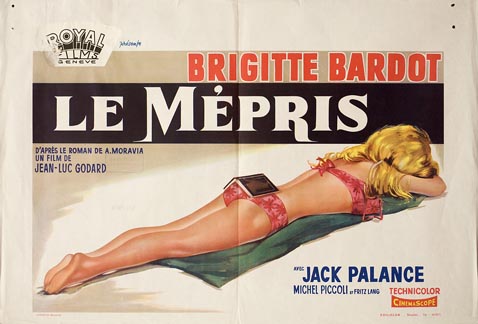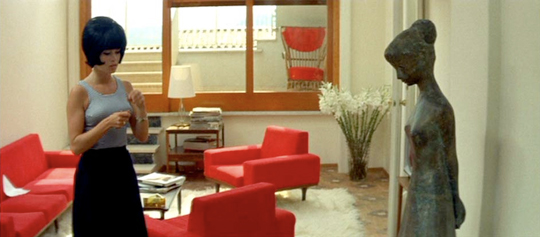Contempt opens with a naked Brigitte Bardot asking her beaux Paul (diagetically) and you (extra-narratively) whether you like her butt. Specifically, she asks Paul ((Michel Piccoli) whether he can see various body parts in the (off-screen) mirror, and what he thinks of them. He is (as who wouldn’t be?) appreciative.
The scene is charmingly sexy. It’s also a tease, in more ways than one. Camille (that is, Bardot’s character) doesn’t ask what Paul thinks of her; she asks what he thinks of her image. Of course, we’re looking at the real Camille, not the image — except, of course, of course, we aren’t looking at the real Camille, because there is no real Camille — just an onscreen image of Bardot. The flirtation here, then, is not just Paul playing with Camille, but Godard playing with both of them, and with the idea of image and reality. The scene is less a love letter from a man to a woman than a love letter to the beautiful image of an ass.
The rest of Contempt is almost as self-reflexive as that opening scene. Paul, a theater-writer, is given the opportunity by the crass American producer Jerry (Jack Palance) to rewrite a script about the Odyssey by Fritz Lang (playing himself.) Paul is deeply ambivalent about working on the screenplay; Jerry is a bore, and Lang, who Paul deeply respects, doesn’t want the script changed. In the course of Paul’s vacillations, Jerry casually hits on Camille and Paul himself makes a half-hearted pass at Jerry’s translator/assistant. Somewhere in there, Camille decides she no longer loves Paul. In fact, she despises him.
In a review of the film a few weeks back, Robert Stanley Martin argued that Contempt is about the collapse of communication in a marriage. As Robert says:
Paul is essentially declaring himself a whore, and it’s clear that his seeing it as being for Camille’s benefit leads him to blame her for his situation. He doesn’t stand in the way of the producer’s efforts to come on to her, and he humiliates her further by letting his attention (and hands) wander to the producer’s pretty assistant in her presence. She drops every hint she can that she doesn’t want him to do this job. She even tells him how much happier she was when they didn’t have money and he was hacking out crime novels for a living. But she’s relying on rapport to tell him how she feels; telling him outright means their love isn’t strong enough to do the job. His resentments stand in the way.
That’s a basically naturalistic reading of the film — for it to work, you have to be willing to believe, at least provisionally, that Camille and Paul’s relationship is real. And, at least for me, that wasn’t really possible. A love that could vanish as suddenly and hopelessly as Camille’s love vamished — over the course of a few hours, as both Paul and Camille say — wasn’t really a love to begin with. It was just an image, or a trope.
In fact, Camille’s contempt for Paul seems to be almost entirely a convenient reflection of his contempt for himself. No sooner does Paul accept a check from Jerry than he’s thrusting Camille into a sports car with the oleaginous producer. She’s less a wife than a masochistic fantasy; a dream of defilement. The delirious, endless scene in their apartment — in which the camera shoots the pair passing through doors and hallways or exchanging places in the bath, setting the table and clearing it without eating — has the too-vivid timelessness of a dream. Nothing gets said or understood not because communication between two people has failed, but because that apartment is a skull and there’s only one person in there. Perhaps that one person is Paul; perhaps (as is suggested when Bardot dons a black wig making her resemble the filmmaker’s wife Anna Karina) it’s Godard. But it’s not Camille.
Godard certainly thinks about the way that Camille is a thought. Throughout the film, both Jerry and Paul reimagine the story of the Odyssey in an effort to justify their own view of their relationship with Camille. Jerry speculates early on that Penelope was actually unfaithful to Odysseus; a not-very-subtle wish that Camille will be unfaithful to Paul. Later, Paul imagines that Odysseus stayed away from Ithaca for so long not because he couldn’t get back, but because he had marital troubles and didn’t want to come home. He also grabs a gun and talks briefly about Odysseus murdering Penelope’s suitors, clearly flirting with the idea of killing Jerry.
You could argue that the film is critiquing Jerry and Paul; that it’s undermining or ridiculing their efforts to make Camille their own narrative Pygmalion. Certainly there’s some of that going on; Paul, for example, actually drops that gun without realizing it and someone has to give it back to him — his gangsta dreams are profoundly ridiculous. But, at the same time…Jerry’s dreams do come true; Camille is unfaithful with him. And while Paul doesn’t kill his rival, the film — which is at least somewhat linked to Paul’s consciousness — is happy to do it for him. Jerry and Camille are killed in a gratuitously melodramatic, feebly ironic car crash after they tootle off together, finishing off Paul’s job and his relationship in a single bitterly masochistic ecstasy of revenge.
I was talking about this essay with Caro by email a little bit, and she argued that the unreality of Godard’s characters was not a weakness, but a meta-commentary. “The film is not…about lived reality, but filmed reality,” she said. “So the depiction is of the meaning of the depiction of woman on camera, of man on camera, not about men and women.” Clearly, there’s a lot of truth to that. We’re not supposed to look at Paul, or even at Godard, but at the film of Paul or of Godard. They aren’t asses, but images of asses. You are not meant to identify with them so much as you are meant to contemplate their assness.
But a contemplation of assness is not necessarily, or not only, the same as a critique of assness. Indeed, often, as with Bardot in the opening scene, the contemplation is a pleasure. From its opening shot of a camera on a dolly filming through its sudden interpolations of dramatic shots of statuary to the on-again, off-again dramatically swelling soundtrack to the avuncular presence of Fritz Lang, to that virtuoso dialogue in the apartment, Contempt is boisterously, seductively enamored with its own image. Godard certainly is aware that the woman-as-image, as projection of male sado-masochistic desires and fears, is itself an image. But that image-of-an-image is still irresistibly alluring. Bardot in a wig is a joke about the filmmaker turning Bardot into his wife — but that doesn’t change the fact that he’s turning Bardot into his wife. Camille dead in a convenient car crash is an ironic comment about male ego and filmic wish fulfillment — but the self-referential knowingness just fetishizes the self-reference on top of the wish fulfillment, savoring not the beauty of the dead woman, but the beauty of the reflection of the dead woman. However many lenses you look through, Camille is still a thing in his dream, and contempt is still a pleasure.
_____________
The index to the Godard roundtable is here.



Noah Berlatsky – Nice job. I’ve loved “Contempt” since I was a teenager, 30+ years ago. I enjoyed your essay.
“The apartment is a skull!’ Fantastic.
Aw, thanks, both of you!